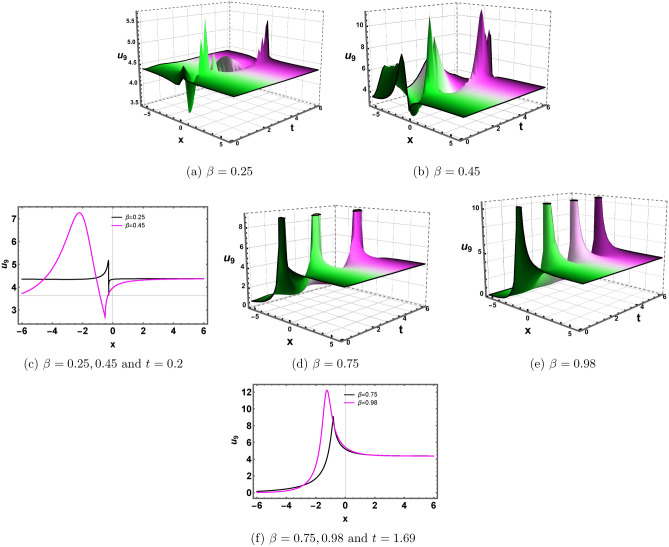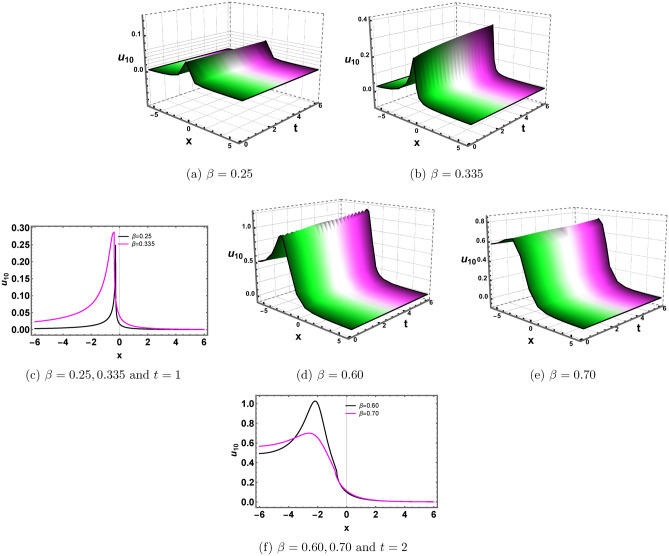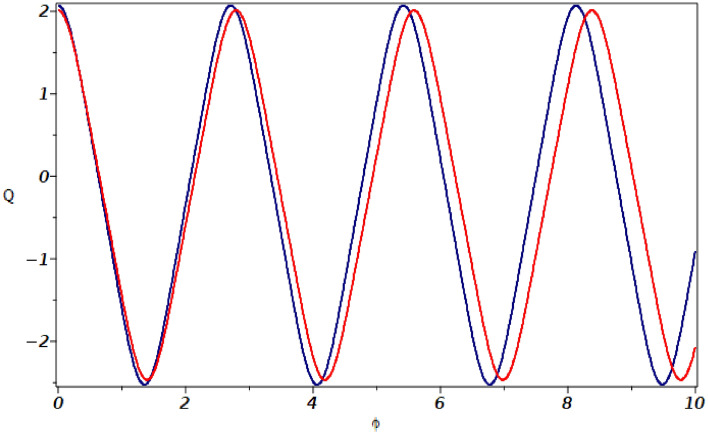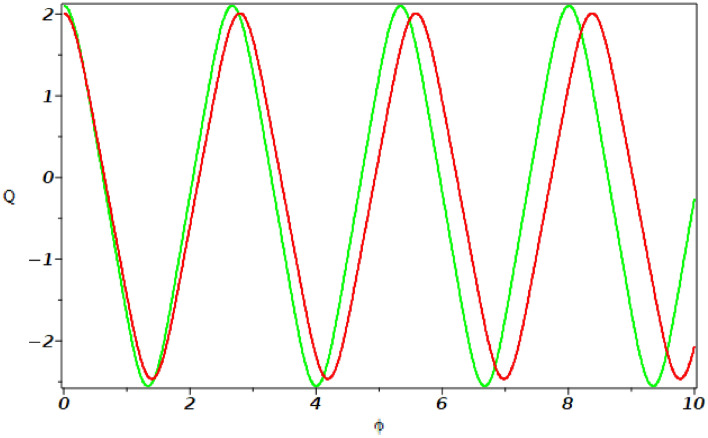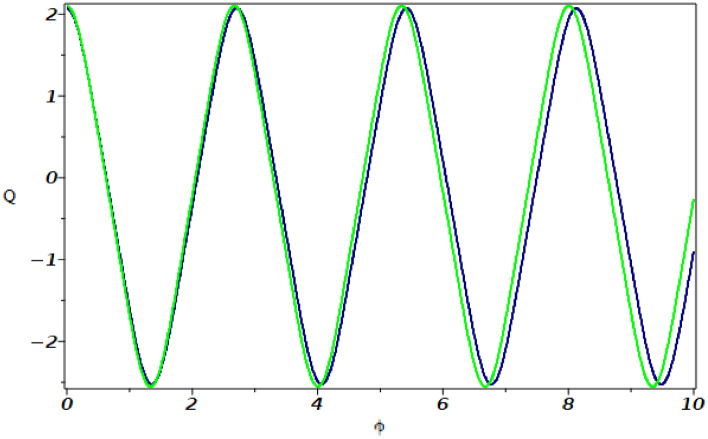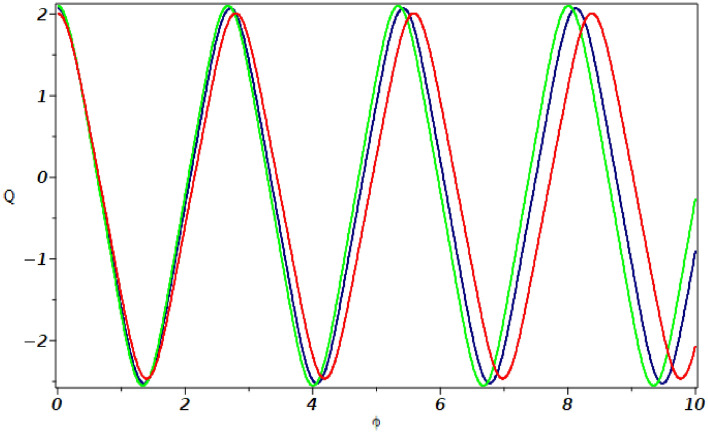Abstract
Solitary wave solutions to the nonlinear evolution equations have recently attracted widespread interest in engineering and physical sciences. In this work, we investigate the fractional generalised nonlinear Pochhammer–Chree equation under the power-law of nonlinearity with order m. This equation is used to describe longitudinal deformation wave propagation in an elastic rod. In this study, we have secured a variety of exact solitary wave solutions by the assistance of the recently developed technique known as modified generalized exponential rational function method. Exact solutions of various categories, such as bright-dark, bright, mixed, singular, dark, complex, and combined solitons, are extracted. The applied approach is highly efficient and has a significant computational capability to efficiently tackle the solutions with a high degree of accuracy in nonlinear systems. To analyze the governing system, the equation under investigation is converted to an ordinary differential equation through the application of a suitable wave transformation with a
Keywords: Modified generalized exponential rational function method, Solitons, Generalised nonlinear Pochhammer–Chree equation,
Subject terms: Engineering, Mathematics and computing
Introduction
Nonlinear partial differential equations (NLPDEs) have a considerable influence on the study of nonlinear physical sciences. These equations are often used to elucidate many intricate natural phenomena. NLPDEs are mainly used to characterize the behaviors of waves in the form of solitons and solitary waves. As a result, the investigation of nonlinear waves plays a substantial role in our daily lives and in a variety of research fields, including hydrodynamics1, fluid dynamics and mechanics2, earth science3, solid-state physics4, water waves5, chaos theory6, quantum mechanics7, and many others. These expanded models encouraged a multitude of potential research projects and significantly elucidated the physical properties of engineering and physics applications. Consequently, the study of NLPDEs has consistently attracted considerable interest in recent years. Nonlinear differential equations represent various scientific experimental models. To comprehend the intrinsic characteristics of the nonlinear model, analytical and accurate solutions to the models are essential. It is necessary to investigate the solutions and characteristics of NLPDEs in order to understand the structure they represent. Researchers have developed a number of efficient methods using symbolic computations to ensure the accuracy of soliton solutions to NLPDEs. Numerous problem-solving methods have their own advantages and requirements when used in management models. NLPDEs are now widely recognized as the most comprehensive way for defining the physical significance of nonlinear scenarios occurring in the fields of science and engineering.
Numerous studies have demonstrated the characteristics of soliton solutions and their applications in various scientific and technological domains. Soliton theory is a significant field of research in the fields of applied mathematics and mathematical physics. Solitons are wave bundles that are self-sustaining and maintain their shape while traveling at a constant speed, as defined by mathematics and physics. There are numerous varieties of solitons, including dark, bright, peakons, anti-kink, kink, temporal, spatiotemporal, spatial, and singular. There have been numerous investigations that have demonstrated the diverse characteristics of soliton solutions and their applications in scientific and technological fields8. Numerous disciplines, such as fluid dynamics, plasma physics, nonlinear optics, coastal engineering, and communications engineering, have significant uses for soliton solutions. They are essential for the advancement of global communication. Advanced analytical and numerical strategies have been devised by mathematicians to ascertain the soliton solutions of various NLPDEs. Soliton waves are gaining significance in a variety of fields, such as nonlinear optics, optical fibers, and ferromagnetic materials. This multidisciplinary approach, which integrates mathematics, computer science, and physics, demonstrates the dynamic nature of scientific research when it is applied to real-world issues. By acquiring a more thorough comprehension of soliton waves, researchers may make progress in these fields and investigate novel applications.
Exact solutions are of significant importance in the investigation of physical behaviors in a variety of physical systems, as they provide a foundation for subsequent research and investigations. Characterizing the behaviors of any physical system as an ordinary differential equation (ODE) or PDE is the only feasible way of obtaining an exact solution. The preponderance of natural or industrial complex phenomena can be modeled using NLPDEs or FNLPDEs. In order to achieve analytic solutions to these issues, different methodologies and strategies have been developed by a number of academicians, such that, truncated Painlevé approach9, Master stability function10, improved F-expansion function method11, Lie symmetry technique12, simplest equation technique13, networking of higher of higher order systems14, iterative transform method15, Intelligent Detection Method16, Hirota bilinear method17, Lie classical approach12, Adomian decomposition technique18, bifurcation analysis19,
Consequently, the model in concern has not been investigated using the proposed methodology, despite a comprehensive examination of the existing literature. Therefore, the current study aims to make use of this analytical methodology to clarify the complex dynamics that are inherent in the generalized nonlinear Pochhammer–Chree (PC) equation. Pochhammer34 and Chree35 simultaneously deduced the equation of motion in cylindrical coordinates to characterize the propagation of a sinusoidal wave with frequency f through an infinitely long homogeneous, isotropic cylinder with a uniform cross-section. Inspired by the work of Pochhammer and Chree, a frequency equation was formulated and introduced by Love36 and numerical solution presented by Bancroft37. This study aims to improve the understanding of these intricacies and contribute to advances in the field of analysis of complex phenomena by implementing the proposed method. Here, our main goal is to study various soliton solutions of the fractional PC equation by applying an integration method called the modified generalized exponential rational function method (mGERFM)38. Furthermore, the applied method is well suited for nonlinear complex models, as it enable obtaining results in a simple and straightforward manner and is capable of generating a variety of new results and providing guidance for organizing them.
The article is structured as follows: Section “Fractional order derivative” covers the fundamental definitions and some of the most significant properties of fractional derivative. Section “The governing equation” provides the governing generalized nonlinear PC equation, while Section “Extraction of solutions for
Fractional order derivative
Fractional differential equation are equations where the derivatives have fractional orders instead of integer orders. Soliton’s theory presents a multitude of fractional, nonlinear challenges. Researchers use fractional calculus and the development of innovative operators, such as Atangana Baleanu derivative39, Riemann-Liouville derivative40, and Caputo derivative41, to solve some of the most important contemporary problems. The fractional models exhibit superior precision and accuracy in comparison to their integer-order counterparts, closely matching the experimental data. The fractional form facilitates the implementation of sophisticated optimization and control strategies that enhance the overall performance of a system.
Definition 1
Suppose that
| 1 |
Theorem 1
44
Let
\documentclass[12pt]{minimal} \usepackage{amsmath} \usepackage{wasysym} \usepackage{amsfonts} \usepackage{amssymb} \usepackage{amsbsy} \usepackage{mathrsfs} \usepackage{upgreek} \setlength{\oddsidemargin}{-69pt} \begin{document}$${\mathscr {D}}_{t}^{\beta }\left( c\{\kappa (t)\}+d\{ h(t)\}\right) =c{\mathscr {D}}_{t}^{\beta }\{\kappa (t)\}+d{\mathscr {D}}_{t}^{\beta }\{h(t)\},~\text { for all } c,~d\in {\mathbb {R}}$$\end{document} .\documentclass[12pt]{minimal} \usepackage{amsmath} \usepackage{wasysym} \usepackage{amsfonts} \usepackage{amssymb} \usepackage{amsbsy} \usepackage{mathrsfs} \usepackage{upgreek} \setlength{\oddsidemargin}{-69pt} \begin{document}$${\mathscr {D}}_{t}^{\beta }\left( \{\kappa (t)\}\times \{h(t)\}\right) = \{h(t)\}{\mathscr {D}}_{t}^{\beta }\left( \{\kappa (t)\}\right) +\{\kappa (t)\}{\mathscr {D}}_{t}^{\beta }\left( \{h(t)\}\right)$$\end{document} .\documentclass[12pt]{minimal} \usepackage{amsmath} \usepackage{wasysym} \usepackage{amsfonts} \usepackage{amssymb} \usepackage{amsbsy} \usepackage{mathrsfs} \usepackage{upgreek} \setlength{\oddsidemargin}{-69pt} \begin{document}$${\mathscr {D}}_{t}^{\beta }\left( \frac{\{\kappa (t)\}}{\{h(t)\}}\right) =\frac{\{h(t)\}{\mathscr {D}}_{t}^{\beta }\{\kappa (t)\}-\{\kappa (t)\}{\mathscr {D}}_{t}^{\beta }\{h(t)\}}{\left( \{h(t)\}\right) ^2}$$\end{document} .\documentclass[12pt]{minimal} \usepackage{amsmath} \usepackage{wasysym} \usepackage{amsfonts} \usepackage{amssymb} \usepackage{amsbsy} \usepackage{mathrsfs} \usepackage{upgreek} \setlength{\oddsidemargin}{-69pt} \begin{document}$${\mathscr {D}}_{t}^{\beta }\{\kappa (t)\}=\frac{d\{\kappa (t)\}}{dt}\left( t+\frac{1}{\Gamma (\beta )}\right) ^{1-\beta }$$\end{document} .\documentclass[12pt]{minimal} \usepackage{amsmath} \usepackage{wasysym} \usepackage{amsfonts} \usepackage{amssymb} \usepackage{amsbsy} \usepackage{mathrsfs} \usepackage{upgreek} \setlength{\oddsidemargin}{-69pt} \begin{document}$${\mathscr {D}}_{t}^{\beta }\{c(t)\}=0, ~~ {where }$$\end{document} c(t) is a constant
The governing equation
Integral systems are indispensable for the analysis of various types of nonlinear equations due to their applicability across a wide range of scientific disciplines. These systems are highly applicable in the fields of nanophysics and applied magnetism, as well as possessing remarkable geometric and gauge invariance properties. Among many integrable system, the generalized nonlinear fractional PC equation45–48 read as:
| 2 |
where
Extraction of solutions for m = 1
To solve Eq. (2), for
| 3 |
Subsequently, consider
| 4 |
| 5 |
where k is a scaler parameter and v is the wave speed. By employing the aforementioned transformations in Eq. (3), we obtain the following:
| 6 |
Furthermore, we get the nonlinear ordinary differential equation (ODE) as follows by integrating Eq. (6) twice and setting the integration constant to zero:
| 7 |
Moreover, the suggested method is applied to analyze the Eq. (7). Using the balance principle between the terms
Application of the method
The applied method is versatile approach applicable to a wide range of nonlinear differential equations of different types. The mGERFM38 solution is given as:
| 8 |
where
| 9 |
In this study, we have taken the few families from the suggested reference and some other families have been selected by considering the appropriate values for r and s, which produce the function
| 10 |
The exponential soliton solution
| 11 |
The explicit hyperbolic solution
| 12 |
| 13 |
| 14 |
| 15 |
| 16 |
| 17 |
| 18 |
| 19 |
| 20 |
| 21 |
| 22 |
Fig. 1.
Plots of Eq. (19) for
Fig. 2.
Plots of Eq. (20) for
Solutions for m = 2
For
| 23 |
Next, we apply the transformation described by
| 24 |
| 25 |
where c is the wave speed. Using the above relation in Eq. (23), we acquire:
| 26 |
Moreover, the nonlinear ODE is obtained by integrating Eq. (26) twice and setting the integration constant to zero:
| 27 |
When homogeneous balance principle is applied to the terms
| 28 |
The balance principle between the terms
The exponential soliton solution
| 29 |
The explicit hyperbolic solution
| 30 |
| 31 |
| 32 |
| 33 |
| 34 |
| 35 |
| 36 |
where the hyperbolic solution is written as
| 37 |
Fig. 3.
Plots of Eq. (29) for
Fig. 4.
Plots of Eq. (30) for
Sensitivity analysis
This section explores the sensitivity analysis of the proposed model. Applying the Galilean transformation, Eq. (7) can be reconfigured into two separate systems of equations. Under the assumption that
| 38 |
where
The system (38) is solved using the Runge-Kutta method by applying the suitable parameter values for
Fig. 5.
Sensitivity analysis of system (38) with initial conditions
Fig. 6.
Sensitivity analysis of system (38) with initial conditions
Fig. 7.
Sensitivity analysis of system (38) with initial conditions
Fig. 8.
Sensitivity analysis of system (38) with initial conditions. Three solutions, red, navy blue, and green, indicated by
Discussion and concluding remarks
The PC equation, a mathematical framework for modeling nonlinear longitudinal wave propagation in elastic media, is widely applicable in various fields of physics and engineering. In particular, the equations include nonlinear effects associated with scenarios involving high-amplitude wave motion. Researchers have extensively employed the PC equation to investigate a wide range of real-world phenomena. Examples of these phenomena include transverse vibrations in structures, large-amplitude seismic wave propagation, nonlinear acoustics in pipes, tubes, and granular materials, as well as solitons and solitary wave dynamics. The PC equation’s versatility in encapsulating wave motion in elastic medium is demonstrated in biomechanics and biofluids, revealing its nonlinear physics of wave motion. The present study aims to enhance comprehension of the diverse physical systems described by the PC equation across multiple disciplines by offering solutions and insights into this fundamental model. The generalized nonlinear PC equation has been thoroughly examined in this study with the aid of the
As a result, our study’s findings are particularly important in understanding the propagation of longitudinal waves through elastic rods. Through nonlinear wave dynamics, the solitary waves have the capacity to influence material behaviors and applications associated with energy transmission. This research work can serve as a basis for exploring various potential solutions, encouraging further research on other profiles. New research enhances understanding of solitary waves governed by PC equations, revealing unexpected changes that were previously unnoticed. This broadens the spectrum of known solutions and enriches the theoretical foundation of wave physics.
Author contributions
J.M.: Writing-original draft, Methodology; U.Y.: Formal analysis, Software; E.H.: Qualitative Analysis; Q.A.: Visualization, Validation; M.S.: Writing - original draft; Writing - review & editing; K.K.: Writing - review, Supervision, Formal analysis; A.Z.J.: Formal analysis and Graphics.
Data availability
All data that support the findings of this study are included in the article.
Declarations
Competing interest
The authors declare no competing interests.
Footnotes
Publisher’s note
Springer Nature remains neutral with regard to jurisdictional claims in published maps and institutional affiliations.
References
- 1.Bonnemain, T., Doyon, B. & El, G. Generalized hydrodynamics of the KdV soliton gas. J. Phys. A: Math. Theor.55(37), 374004 (2022). [Google Scholar]
- 2.Petrila, T. & Trif, D. Basics of Fluid Mechanics and Introduction to Computational Fluid Dynamics (Springer Science & Business Media, 2004). [Google Scholar]
- 3.Bykov, V. G. Nonlinear waves and solitons in models of fault block geological media. Russ. Geol. Geophys.56(5), 793–803 (2015). [Google Scholar]
- 4.Ozisik, M. & Akbarov, S. D. Rayleigh-wave propagation in a half-plane covered with a prestressed layer under complete and incomplete interfacial contact. Mech. Compos. Mater.39, 177–82 (2003). [Google Scholar]
- 5.Hereman, W. Shallow water waves and solitary waves. In Solitons pp. 203–220 (Springer US, 2022).
- 6.Jie-Fang, Z., Chun-Long, Z., Jian-Ping, M. & Jian-Ping, F. Chaotic dynamical behaviour in soliton solutions for a new (2+ 1)-dimensional long dispersive wave system. Chin. Phys. Lett.20(4), 448 (2003). [Google Scholar]
- 7.Faddeev, L. D. & Korepin, V. E. Quantum theory of solitons. Phys. Rep.42(1), 1–87 (1978). [Google Scholar]
- 8.Xi, X., Li, J., Wang, Z., Tian, H. & Yang, R. The effect of high-order interactions on the functional brain networks of boys with ADHD. Eur. Phys. J. Spec. Top.233, 817–829 (2024). [Google Scholar]
- 9.Raza, N., Rani, B., Chahlaoui, Y. & Shah, N. A. A variety of new rogue wave patterns for three coupled nonlinear Maccari’s models in complex form. Nonlinear Dyn.111, 18419–18437 (2023). [Google Scholar]
- 10.Wang, Z. et al. Synchronization patterns in a network of diffusively delay-coupled memristive Chialvo neuron map. Phys. Lett. A514–515, 129607 (2024). [Google Scholar]
- 11.Akram, S., Ahmad, J., Rehman, S. U. & Ali, A. New family of solitary wave solutions to new generalized Bogoyavlensky-Konopelchenko equation in fluid mechanics. Int. J. Appl. Comput. Math.9, 63 (2023). [Google Scholar]
- 12.Raza, N., Salman, F., Butt, A. R. & Gandarias, M. L. Lie symmetry analysis, soliton solutions and qualitative analysis concerning to the generalized q-deformed Sinh-Gordon equation. Commun. Nonlinear Sci. Numer. Simul.116, 106824 (2023). [Google Scholar]
- 13.Chen, C. & Jiang, Y. L. Simplest equation method for some time-fractional partial differential equations with conformable derivative. Comput. Math. Appl.75(8), 2978–88 (2018). [Google Scholar]
- 14.Wang, Z., Chen, M., Xi, X., Tian, H. & Yang, R. Multi-chimera states in a higher order network of Fitz Hugh-Nagumo oscillators. Eur. Phys. J. Spec. Top.233, 779–786 (2024). [Google Scholar]
- 15.Shah, N. A., Agarwal, P., Chung, J. D., El-Zahar, E. R. & Hamed, Y. S. Analysis of optical solitons for nonlinear Schrödinger equation with detuning term by iterative transform method. Symmetry12(11), 1850 (2020). [Google Scholar]
- 16.Yu, T., Chen, W., Junfeng, G. & Poxi, H. Intelligent detection method of forgings defects detection based on improved efficient net and memetic algorithm. IEEE Access10, 79553–79563 (2022). [Google Scholar]
- 17.Younas, U., Ren, J., Sulaiman, T. A., Bilal, M. & Yusuf, A. On the lump solutions, breather waves, two-wave solutions of (2+1)-dimensional Pavlov equation and stability analysis. Mod. Phys. Lett. B36, 2250084 (2022). [Google Scholar]
- 18.Duan, J. S., Rach, R., Baleanu, D. & Wazwaz, A. M. A review of the Adomian decomposition method and its applications to fractional differential equations. Commun. Fract. Calculus3(2), 73–99 (2012). [Google Scholar]
- 19.Zhu, C., Al-Dossari, M., Rezapour, S., Alsallami, S. A. M. & Gunay, B. Bifurcations, chaotic behavior, and optical solutions for the complex Ginzburg-Landau equation. Results Phys.59, 107601 (2024). [Google Scholar]
- 20.Batool, A., Raza, N., Gomez-Aguilar, J. F. & Olivares-Peregrino, V. H. Extraction of solitons from nonlinear refractive index cubic-quartic model via a couple of integration norms. Opt. Quant. Electron.54(9), 549 (2022). [Google Scholar]
- 21.Wan, P., Manafian, J., Ismael, H. F. & Mohammed, S. A. Investigating one-, two-, and triple-wave solutions via multiple exp-function method arising in engineering sciences. Adv. Math. Phys.8, 1–8 (2020). [Google Scholar]
- 22.Hosseini, K., Samadani, F., Kumar, D. & Faridi, M. New optical solitons of cubic-quartic nonlinear Schrödinger equation. Optik157, 1101–1105 (2018). [Google Scholar]
- 23.Zhu, C., Al-Dossari, M., Rezapour, S. & Gunay, B. On the exact soliton solutions and different wave structures to the (2+1) dimensional Chaffee-Infante equation. Results Phys.57, 107431 (2024). [Google Scholar]
- 24.Gözükızıl, Ö. F. & Akçaǧıl, Ş. The tanh-coth method for some nonlinear pseudoparabolic equations with exact solutions. Adv. Differ. Equ.143, 1–18 (2013). [Google Scholar]
- 25.Iedaa, J. Inverse scattering method for square matrix nonlinear Schrödinger equation under nonvanishing boundary conditions. J. Math. Phys.48, 013507 (2007). [Google Scholar]
- 26.Conte, R., Musette, M. & Grundland, A. M. Bäcklund transformation of partial differential equations from the Painlevé-Gambier classification, II. Tzitzeica equation. J. Math. Phys.40(4), 2092–2106 (1999). [Google Scholar]
- 27.Zhu, C., Al-Dossari, M., Rezapour, S., Shateyi, S. & Gunay, B. Analytical optical solutions to the nonlinear Zakharov system via logarithmic transformation. Results Phys.56, 107298 (2024). [Google Scholar]
- 28.Kai, Y., Ji, J. & Yin, Z. Study of the generalization of regularized long-wave equation. Nonlinear Dyn.107, 2745–2752 (2022). [Google Scholar]
- 29.Ismael, H. F., Sulaiman, T. A., Younas, U. & Nabi, H. R. On the autonomous multiple wave solutions and hybrid phenomena to a (3+1)-dimensional Boussinesq-type equation in fluid mediums. Chaos Solitons Fractals187, 115374 (2024). [Google Scholar]
- 30.Nasreen, N., Muhammad, J., Jhangeer, A. & Younas, U. Dynamics of fractional optical solitary waves to the cubic-quintic coupled nonlinear Helmholtz equation. Part. Differ. Equ. Appl. Math.11, 100812 (2024). [Google Scholar]
- 31.Muhammad, J. et al. Analysis of fractional solitary wave propagation with parametric effects and qualitative analysis of the modified Korteweg-de Vries-Kadomtsev-Petviashvili equation. Sci. Rep.14, 19736 (2024). [DOI] [PMC free article] [PubMed] [Google Scholar]
- 32.Muhammad, J., Rehman, S. U., Nasreen, N., Bilal, M. & Younas, U. Exploring the fractional effect to the optical wave propagation for the extended Kairat-II equation. Nonlinear Dyn. (2024).
- 33.Younas, U. & Yao, F. Dynamics of fractional solitonic profiles to multicomponent Gross-Pitaevskii system. Phys. Scr.99, 085210 (2024). [Google Scholar]
- 34.Pochhammer, L. Uber die fortpflanzungsgeschwindigkeiten kleiner schwingungen in einem unbegrenzten isotropen kreiszylinder, Journal fur die reine und angewandte Mathematik (ed. Borchardt, C. W.) vol. 81, pp. 324–336 (De Gruyter, 1876).
- 35.Chree, C. The equations of an isotropic elastic solid in polar and cylindrical co-ordinates. Trans. Cambridge Philos. Soc.14, 250–369 (1889). [Google Scholar]
- 36.Love, A. A Treatise on the Mathematical Theory of Elasticity 4th edn. (Cambridge University Press, 1927). [Google Scholar]
- 37.Bancroft, D. The velocity of longitudinal waves in cylindrical bars. Am. Phys. Soc. Phys. Rev.59, 588–593 (1941). [Google Scholar]
- 38.Rehman, S. U., Ahmad, J. & Muhammad, T. Dynamics of novel exact soliton solutions to Stochastic Chiral Nonlinear Schrödinger equation. Alex. Eng. J.79, 568–580 (2023). [Google Scholar]
- 39.Atangana, A. & Baleanu, D. New Fractional Derivatives with Nonlocal and Non-singular Kernel: Theory and Application to Heat Transfer Model. arXiv preprint, (2016).
- 40.Hilfer, R. Fractional diffusion based on Riemann-Liouville fractional derivatives. J. Phys. Chem. B104(16), 3914–7 (2000). [Google Scholar]
- 41.Diethelm, K. General theory of Caputo-type fractional differential equations. Handb. Fract. Calculus Appl. Basic Theory2, 1–20 (2019). [Google Scholar]
- 42.Atangana, A. & Alqahtani, R. T. Modelling the spread of river blindness disease via the caputo fractional derivative and the beta-derivative. Entropy18(2), 40 (2016). [Google Scholar]
- 43.Gutierrez, R. E., Rosario, J. M. & Tenreiro Machado, J. Fractional order calculus: Basic concepts and engineering applications. Math. Probl. Eng.2010(1), 375858 (2010). [Google Scholar]
- 44.Atangana, A., Baleanu, D. & Alsaedi, A. Analysis of time-fractional Hunter-Saxton equation: A model of neumatic liquid crystal. Open Phys.14(1), 145–149 (2016). [Google Scholar]
- 45.Hossain, A. K. & Akbar, M. A. Solitary wave solutions of few nonlinear evolution equations. AIMS Math.5(2), 1199–215 (2020). [Google Scholar]
- 46.Seadawy, A. R. et al. Modulation instability analysis and longitudinal wave propagation in an elastic cylindrical rod modelled with Pochhammer–Chree equation. Phys. Scr.96(4), 045202 (2021). [Google Scholar]
- 47.Geng, T. & Shan, W. R. A new application of Riccati equation to some nonlinear evolution equations. Phys. Lett. A372(10), 1626–30 (2008). [Google Scholar]
- 48.Zulfiqar, A., Ahmad, J. & Ul-Hassan, Q. M. Analysis of some new wave solutions of fractional order generalized Pochhammer–Chree equation using exp-function method. Opt. Quant. Electron.54(11), 735 (2022). [Google Scholar]
Associated Data
This section collects any data citations, data availability statements, or supplementary materials included in this article.
Data Availability Statement
All data that support the findings of this study are included in the article.



